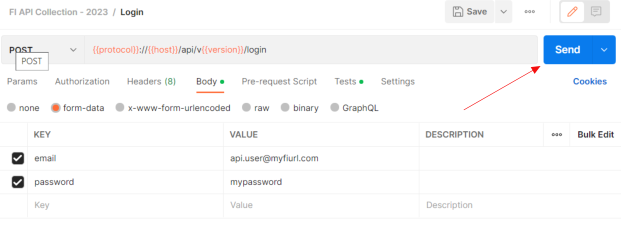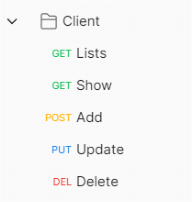The FusionInvoice API
The FusionInvoice API allows you to programmatically manage clients, invoices, quotes, payments, and related resources within your FusionInvoice system. This API provides both read and write capabilities, enabling integration with other business systems or custom tooling.
Getting Started
For the purposes of testing, we are using Postman. You can use whatever API testing tool you prefer - The Postman collection can be found at the link below:.
Below are the variables we have set up for our local environment to make testing easier. Note that the token value must be retrieved using the login endpoint. More on that next.
Your API auth token can be retrieved by using the FusionInvoice login endpoint. Before doing this, it’s a good idea to create a new admin level user within your FusionInvoice installation, which you will use for API calls. For instance, create a called api user with an email of
[email protected] and make note of the password. Next, we’ll go back to Postman and call the login endpoint with this new user’s credentials. (see example below)
Click the Send button and your personal access token will be generated. You will see it in the response area.
At this point, you can go back to your Postman environment variables and paste in the value from the token you received. (In this example you would paste in the value starting with 2|Wlf. Do not paste the quotation marks. Now that you have a token saved to your environment, you should be able to start making API calls from Postman.
How the API endpoints are organized
Our endpoints are organized by module and we currently support:
- Client
- Invoices
- Quotes
- Payments
Let’s explore the Client endpoints first. There are 5 endpoints that can be called for clients.
List endpoints end in the name of the module, for instance the list endpoint for clients would be something like: https://myfiurl.com/api/v1/clients
List endpoints support many query parameter options for filtering criteria.
•paginated_response
•include_custom_fields
•active
In addition, you can specify any valid field name that matches (or does not match) a certain value. For instance, if we wanted to retrieve a list of clients that had a timezone in America, we would add a “timezone” key and give it a value of “america”.
If you add multiple key values to filter by, the conditions are joined with an OR operator. For instance, timezone=america OR name=acme shoe repair. However, you can change the operator to an AND condition by adding the key “where_operator” and giving it a value of “AND”. The OR or AND operator works on the entire expression and at this time you cannot mix and match OR and AND operators.
Show endpoints are meant to fetch the data for a single record. In the case of a client, we would specify the ID of the client to show in the URL. Ie. https://myfiurl.com/api/v1/clients/2
List endpoints support many query parameter options for filtering criteria.
- include_custom_fields
Add endpoints use an POST method and are used to add a new record and have a URL ending with “/store”. In the case of a client, https://myfiurl.com/api/v1/clients/store
There are several required fields for each add endpoint. In the case of clients, the required fields are:
•name
•email
•type
You can however pass any valid field name and value pair.
Update endpoints use a PUT method and are used to update an existing record and have a URL ending with ID of the record. A client example, https://myfiurl.com/api/v1/clients/1201
List the fields name and values you would like to update. Here is a JSON body example for the client with ID 1201:
{
“name” : “Barnes and Associates”,
“city” : “Tallahassee””,
“state” : “FL”,
“active” : 1
}
Delete endpoints use a DEL method and are used to delete an existing record. They have a URL ending with ID of the record. A client example, https://myfiurl.com/api/v1/clients/1302
There are no additional parameters for delete endpoints.
Formatting the request parameters
The API can accept parameters as normal URL query stings (key value pairs) or as JSON in the body of the request. The JSON collection included shows both methods in the various examples.
Base URL
All endpoints are accessed via a base URL, which generally follows this pattern:
{{protocol}}://{{host}}/api/v{{version}}/- protocol: Usually
https - host: Your FusionInvoice installation domain (e.g.,
app.yourdomain.com) - version: The current API version (e.g.,
1)
For example:
https://app.yourdomain.com/api/v1/Notes on Authentication
The FusionInvoice API uses Bearer Token authentication. To authenticate:
- Obtain a token by calling the
POST /loginendpoint with valid credentials. - Include the token in subsequent requests via the
Authorizationheader:
Authorization: Bearer {{token}}Request and Response Formats
- Request Formats: Endpoints generally accept JSON or form-data. Check the specific endpoint details for the required content type.
- Response Format: JSON is returned in responses unless otherwise specified.
- Error Handling: If an error occurs (e.g., validation failures, unauthorized access), the response will typically include an HTTP status code (4xx or 5xx) and a JSON payload describing the error.
Pagination
Many listing endpoints support pagination. To enable pagination, include the query parameter paginated_response=1. The response will then include pagination metadata (like current_page, last_page, per_page).
Custom Fields
Some endpoints support include_custom_fields=1 to include custom field data. Additionally, you can filter or search using custom fields by passing parameters such as custom->column_1.
Authentication
Login
Endpoint: POST /login
Description: Obtain a bearer token by providing valid FusionInvoice user credentials.
Form Data Parameters:
email(string, required): Your account email.password(string, required): Your account password.
Example:
curl -X POST "{{protocol}}://{{host}}/api/v{{version}}/login" \
-F "[email protected]" \
-F "password=12345678"Upon success, the response will contain a token you can use for subsequent requests.
Clients
Manage client information, including creation, retrieval, updating, and deletion.
List Clients
Endpoint: GET /clients
Query Parameters:
paginated_response(int, optional):1to paginate results.name(string, optional): Filter clients by name.- Additional filters like
active,include_custom_fields, orcustom->column_xmay be available.
Example:
curl -X GET "{{protocol}}://{{host}}/api/v{{version}}/clients?paginated_response=1&page=1" \
-H "Authorization: Bearer {{token}}"Show Client
Endpoint: GET /clients/{id}
Description: Retrieve details for a single client by ID.
Example:
curl -X GET "{{protocol}}://{{host}}/api/v{{version}}/clients/2" \
-H "Authorization: Bearer {{token}}"Add Client
Endpoint: POST /clients/store
Body (JSON):
unique_name(string, required)name(string, required)email(string, optional)type(string, e.g.,customer)allow_client_center_login(int, 1 or 0)passwordandpassword_confirmation(required ifallow_client_center_login=1)
Example:
curl -X POST "{{protocol}}://{{host}}/api/v{{version}}/clients/store" \
-H "Authorization: Bearer {{token}}" \
-H "Content-Type: application/json" \
-d '{
"unique_name": "Api Prospect11",
"name": "Api Client11",
"email": "[email protected]",
"type": "customer",
"allow_client_center_login": 1,
"password": "12345678",
"password_confirmation": "12345678"
}'Update Client
Endpoint: PUT /clients/{id}
Description: Update client information.
Example:
curl -X PUT "{{protocol}}://{{host}}/api/v{{version}}/clients/33657" \
-H "Authorization: Bearer {{token}}" \
-H "Content-Type: application/json" \
-d '{
"name": "Test API Client",
"allow_client_center_login": "",
"custom": { "column_1": "Test 123456789" }
}'Delete Client
Endpoint: DELETE /clients/{id}
Example:
curl -X DELETE "{{protocol}}://{{host}}/api/v{{version}}/clients/1302" \
-H "Authorization: Bearer {{token}}"Expenses
Allows you to list, view, add, update, and delete expenses.
List Expenses
Endpoint: GET /expenses
Query Parameters:
paginated_response=1for pagination.- Optional filters like
include_custom_fields,search, etc.
Show Expense
Endpoint: GET /expenses/{id}
Example:
curl -X GET "{{protocol}}://{{host}}/api/v{{version}}/expenses/2?include_custom_fields=1" \
-H "Authorization: Bearer {{token}}"Add Expense
Endpoint: POST /expenses/store
Body (form-data):
type(required, e.g.,standard_expense)amount(required iftype=standard_expense)- Other fields like
company_profile_id,vendor_name,category_name,description,expense_date, etc.
Update Expense
Endpoint: POST /expenses/{id}/update
Description: Update an existing expense by ID. Uses form-data parameters similar to adding.
Delete Expense
Endpoint: DELETE /expenses/{id}
Quotes
Manage quotes: list, show, create, add items, custom fields, send email, and download PDF.
List Quotes
Endpoint: GET /quotes
Query Parameters:
paginated_response=1,page,include_custom_fields, etc.
Show Quote
Endpoint: GET /quotes/{id}
Add Quote
Endpoint: POST /quotes/store
Form Data Parameters:
client_nameorclient_idquote_date(Y-m-d)company_profile_id
Delete Quote
Endpoint: DELETE /quotes/delete
Form Data Parameters:
id(the quote ID to delete)
Add Quote Items
Endpoint: PUT /quotes/items/add
Body (JSON):
quote_id(int)name(string)quantity(int)price(numeric)
Add Custom Field to Quote
Endpoint: PATCH /quotes/custom-fields/add
Body (JSON):
quote_idcolumn_1(example custom field)
Send Quote via Email
Endpoint: POST /quotes/email
Form Data Parameters:
id(quote ID)subjectto[]attach_pdf(0 or 1)
Download Quote PDF
Endpoint: GET /quotes/{id}/pdf
Invoices
Manage invoices: list, show, create, add items, send email, download PDF, and apply credit memos.
List Invoices
Endpoint: GET /invoices
Query Parameters:
paginated_response=1,page,include_custom_fields, etc.
Show Invoice
Endpoint: GET /invoices/{id}
Download Invoice PDF
Endpoint: GET /invoices/{id}/pdf
Send Invoice via Email
Endpoint: POST /invoices/email
Form Data Parameters:
id(invoice ID)subjectto[]attach_pdf(0 or 1)
Add Invoice
Endpoint: POST /invoices/store
Form Data Parameters:
client_nameorclient_idinvoice_date(Y-m-d)company_profile_id
Apply Credit Memo to Invoice
Endpoint: POST /invoices/apply/credit-memo
Form Data Parameters:
invoice_idcredit_memo_idamount
Add Invoice Items
Endpoint: PUT /invoices/items/add
Body (JSON):
invoice_idnamequantityprice
Delete Invoice
Endpoint: DELETE /invoices/{id}
Payments
Manage payments: list, show, add, and delete.
List Payments
Endpoint: GET /payments
Show Payment
Endpoint: GET /payments/{id}
Add Payment
Endpoint: POST /payments/store
Form Data Parameters:
payment_method_idpaid_at(date)amountinvoice_idclient_id
Add Custom Fields to Payment
Endpoint: PUT /payments/custom-fields/add
Delete Payment
Endpoint: DELETE /payments/{id}
Client Contacts
Manage client contacts associated with a particular client.
List Client Contacts
Endpoint: GET /clients?name={name}
(Filter by name or other parameters as needed.)
Show Client Contact
Endpoint: GET /client/contact/{id}
Add Contact
Endpoint: POST /client/contact/store
Form Data Parameters:
titlenameprimary_isd_code,primary_phone,primary_is_mobilealternate_isd_code,alternate_phone,alternate_is_mobileemaildefault_to,default_cc,default_bcc(1 or 0)notesclient_id
Update Contact
Endpoint: PUT /client/contact/update/{id}
Body (JSON): Fields similar to adding a contact.
Delete Contact
Endpoint: DELETE /client/contact/{id}
Additional Notes
- Always include the bearer token in authorized requests.
- For complex filtering and searching, refer to the query parameters shown in examples.
- If you encounter issues or need clarification on any endpoint, please contact FusionInvoice support.




